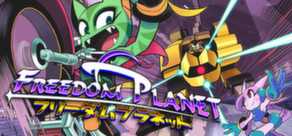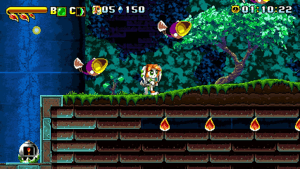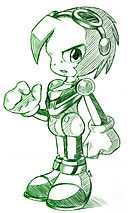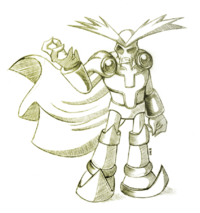Freedom Planet
| Freedom Planet | |
|---|---|
 Steam artwork. Carol is on the motorcycle; Lilac is posing on the right. | |
| Developer(s) | GalaxyTrail |
| Publisher(s) | GalaxyTrail |
| Composer(s) | Woofle Strife BlueWarrior |
| Engine | Sonic Worlds (Clickteam Fusion) |
| Platform(s) | Microsoft Windows, Mac OS X, Wii U |
| Release date(s) | Microsoft Windows
|
| Genre(s) | Platform, action |
| Mode(s) | Single-player |
Freedom Planet is a two-dimensional platform video game created by independent developer GalaxyTrail, a studio set up for the project by designer Stephen DiDuro. The player controls one of three anthropomorphic animal protagonists: the dragon Lilac, the wildcat Carol, or the basset hound Milla. Aided by the duck-like Torque, the player attempts to defeat the evil Lord Brevon, who plans to conquer the galaxy. While the game focuses on fast-paced platforming, its levels are interspersed with slower action scenes.
Freedom Planet began development as a Sonic the Hedgehog fangame, but DiDuro lost interest in creating a derivative work and reconceived the project as his own intellectual property. He visited the website DeviantArt to recruit artist Ziyo Ling, who replaced the existing cast of characters with her own. Lilac, originally a hedgehog, became a dragon; antagonist Doctor Eggman was replaced by Brevon; and the Sonic series' ring-based health system was abandoned. Further changes were suggested by fans and incorporated throughout development. Though Freedom Planet was developed in Denmark, its art direction has East Asian influences: its background visuals were inspired by medieval Chinese art, and the game's title is written in katakana.
The game was released for Microsoft Windows, first as a demo in August 2012, then—after a successful Kickstarter campaign and a few delays—as a full game via Steam on July 21, 2014. A Wii U version is also planned. Freedom Planet has been widely compared to the Sega Genesis Sonic games. Critics praised its gameplay, aesthetics, and balance of Sonic elements with original content, but were more mixed on its pacing and length.
Gameplay

Freedom Planet is a two-dimensional (2D) platform and action game.[1] The player directs one of three characters—Lilac, Carol, or Milla—to run and jump through levels and destroy robotic enemies. Levels contain obstacles such as corkscrews,[2] loop-the-loops,[3] hills, ramps, and rock walls.[4] The player fights a miniboss in the middle of each level[5] and a main boss at the end, after which the story is advanced by cutscenes.[6] Because of its aesthetics, level design, and fast-paced gameplay, Freedom Planet has been compared to the Sonic the Hedgehog games released for the Sega Genesis in the early 1990s.[1][2][3][4][7]
Unlike in Sonic, the player character has a hit point meter instead of a ring-based health system.[2] To refill this meter, the player collects red leaves dropped by enemies and scattered throughout levels.[8] Lilac's maximum health is seven leaves, Carol's six, and Milla's four. Being hit by enemies' and bosses' attacks reduces the character's health, and a life is deducted when no health remains. If all lives are lost, a game over screen appears; however, the player may freely restart from the last checkpoint. Extra lives can be found within levels, as can shield and invincibility-type power-ups.[9]
Each of the playable characters has a basic attack and a special attack.[3] Special attacks, while more powerful, deplete an energy gauge on the heads-up display and cannot be performed again until the gauge has recharged. All three characters have similar basic attacks,[9] but their special attacks differ: Lilac's is an air dash,[2] Carol's is a series of rapid kicks, and Milla throws a gelatinous energy cube at enemies. Carol can wall-jump and ride motorcycles, which are found throughout her levels. Lilac can perform a double jump that also serves as an attack. Milla can fly for a short time by flapping her ears like wings.[10]
The player may complete the game in either the "Adventure" or "Classic" mode. Classic Mode omits the game's cutscenes[6] but allows the player to choose Milla, who is not playable in Adventure. In Adventure Mode, the player does not select a character from the beginning, but instead chooses either Lilac or Carol after an early cutscene in which they temporarily split up.[9] When a stage has been cleared, it is unlocked for time attack mode, wherein the player tries to finish the level in the fastest possible time.[6] The player earns achievements by accomplishing certain goals, such as completing the game or defeating an end-of-level boss with a certain move.[9]
Plot
The game begins as Sash Lilac and Carol Tea—an anthropomorphic dragon and wildcat, respectively—rescue a duck-billed creature named Torque (Patrick M. Seymour) after his spacecraft crash lands. At Torque's request, the three set out to protect a powerful relic called the Kingdom Stone. This involves them in a conflict between three nations on their planet: Shuigang, a country militarized by its new king, Dail; Shang Mu, led by the wealth-obsessed Mayor Zao; and Shang Tu, an airborne city whose Royal Magister is unprepared for war.[11] Lilac and Carol rush to the Kingdom Stone's shrine but are waylaid by the Shang Tu officers General Gong and Neera Li, who doubt that the Stone is threatened. The protagonists arrive just as the Stone is stolen by Spade, a henchman of Zao. After the shrine collapses, Carol is separated from Lilac and pinned by rubble, but she is saved by the timid basset hound Milla Basset.

That night, Torque tells Lilac, Carol, and Milla that he is an alien sent to apprehend the intergalactic warlord Arktivus Brevon, whose spacecraft wrecked on the planet. Brevon has invaded Shuigang, murdered its king, and brainwashed Dail to be his servant. He intends to steal the Stone to power his ship. The protagonists decide to reclaim the Stone from Zao, but they are accosted en route by Spade and by Brevon's assistant Serpentine. The delays give Dail and Brevon's forces time to steal the relic. Afterwards, Zao sends the protagonists as emissaries to Shang Tu to discuss an alliance against Shuigang. They are detained by the Magister upon their arrival, as Neera blames them for the Stone's original disappearance. Torque is acquitted when Lilac falsely pleads guilty. She, Carol, and Milla quickly break out of jail to reunite with Torque, only to see him captured by Brevon and Serpentine.
Carol quarrels with Lilac and storms off. Feeling guilty, Lilac sends Milla to find her and then goes by herself to save Torque from Brevon's nearby base, but she is captured and tortured by Brevon. Meanwhile, Carol and Milla ally with Spade to storm the base, where they rescue Torque and Lilac. However, they are all separated in the ensuing conflict. Neera finds Lilac, arrests her, and brings her back to Shang Tu, where the Magister determines that she is innocent and reveals that Zao is challenging Shuigang for the Stone. Lilac rejoins her friends and convinces Shang Mu and Shang Tu to unite against Dail and Brevon's army. During the battle, Brevon announces that his ship is repaired, and Lilac, Milla, and Carol board it. The team combats Brevon's minions, including a mutated Serpentine. Brevon captures Milla and turns her into a grotesque monster that attacks the other protagonists, who are forced to render her unconscious. Enraged, Lilac and Carol attack and defeat Brevon, but the Kingdom Stone is destroyed in the process. Shortly after the battle, Milla awakens in a medical tent and sees the sky lit up by swirling, crystalline energy released from the Kingdom Stone. The three kingdoms resolve to harness the Stone's power and share it equally, thereby bringing an end to the war. Torque says goodbye to Lilac, Carol, and Milla and returns to space.[11]
Development and release
"Freedom Planet originally began as a direct homage to Sonic. ... As work on the game continued, I felt more and more like it was becoming a waste of time because I was ultimately creaing [sic] something in the shadow of an established franchise and that it would never truly be my own work. So, I set out to try and design a main character that would pay homage to my main source of inspiration while still being unique enough to stand out on her own."
Freedom Planet was conceived by American game designer and programmer Stephen DiDuro, who founded the independent developer GalaxyTrail to create the project. The soundtrack was composed by DiDuro[12] in collaboration with user Blue Warrior of VGMusic.com and user Woofle from Fur Affinity.[7] Although it is an original intellectual property, Freedom Planet was first developed as a Sonic fangame: it contained rings, and Doctor Eggman was the villain. DiDuro decided that the Sonic affiliation would hold back the game and attempted without success to design his own characters. Afterward, he received permission from the Chinese artist Ziyo Ling—whom he had found on the art website DeviantArt—to use her characters Lilac, Carol, and Milla in his game.[8]
Viewers of early footage from the developing product encouraged DiDuro to separate it further from Sonic, so he replaced rings with red leaves and altered the characters' abilities.[8] Ziyo had drawn Lilac as a hedgehog, but DiDuro redesigned the character to be a dragon. Lilac's wall-jump ability was based on a similar game mechanic from Ristar. Originally, her level of energy was to be dependent on her speed, but this proved too difficult to control.[12]


While Freedom Planet was developed in Denmark, its art direction was influenced by medieval East Asian art,[6][10] particularly that of China.[5] The game's visuals reference modern science fiction and fantasy as well.[6] Much of the text in the game world is written in Chinese characters, and the title text is subtitled in Japanese katakana as Furīdamu Puranetto (フリーダム・プラネット). However, no Japanese-language version of the game has been released.[10]
Freedom Planet was first released as a demo for Microsoft Windows in August 2012.[2][4][7] After a full version of the game was funded through Kickstarter, it was taken to Steam Greenlight and approved for Steam.[13] Its release was first projected for early 2014,[7] then delayed to June 30.[5] Shortly before that date, it was delayed again to July 19: the developers wanted to promote the game at a convention in Miami, Florida, and to avoid competition from the heavily discounted products in Steam's Summer Sale.[14] The game was released, after a third delay, on July 21.[15] To advertise the game, GalaxyTrail created branded T-shirts,[13] and Lilac was included as an easter egg in the 2013 game Sonic: After the Sequel.[12] DiDuro considered and rejected the idea of developing an Android version of Freedom Planet, but he is saving money to port the game to the PlayStation Vita.[12] The game was released on the website GOG.com in late 2014.[16] GalaxyTrail is also developing a version for Mac OS X, although only a demo has been released as of January 2015.[17] A version for the Wii U console was announced on March 8, 2015.[18]
Reception
Prerelease
Tony Ponce of Destructoid felt positively about the demo for Freedom Planet; he found it "nice to see a well-established style or formula applied to a new world with original characters".[4] Similarly, Eurogamer's Jeffrey Matulef described the game's preview as "an indie Sonic-esque platformer done right", and he enjoyed the redesigned health system.[2] Dominic Tarison of IndieStatik, whom GalaxyTrail gave an exclusive demo build featuring Milla, complimented the game's "new and unfamiliar configuration" of elements from classic 16-bit games. However, he felt that it "maybe adheres a little too closely to 16-bit limits, especially in the amount of viewable gameplay area."[5][5] John Polson of IndieGames.com believed that "the spectacles like loops and wall runs ... [are not] as magical to do or watch" as in Sonic games, but he nonetheless concluded that "every platformer fan" ought to download the demo.[7]
Nathan Grayson of Kotaku praised the demo for its balance of Genesis Sonic elements and original content: he described the product as "a love letter to classic Sonic, except when it's not". He also praised the game's enemies, and, while he experienced minor control issues, guessed that they may have resulted from his use of an Xbox 360 controller instead of a keyboard. He found the game's pacing to be slower than that of the Genesis Sonic games because of the added combat sequences, which sacrificed the feeling of "getting into a groove with a classic Sonic level", though felt that this gave the player "time to look around, take in the sights, and think, 'Hey, I want to explore that'". He concluded that the game's sense of speed was "solid". Grayson was, however, critical of the voice acting, exclaiming "Yikes".[3][3][3]
Ponce strongly praised the visuals, which he found pleasant to the eye because of their light outlines, though he criticized the bland foreground design.[4] Polson noted minor audio and visual flaws, most notably the recycling of sound effects from Genesis Sonic games, but he lauded the game's music.[7] Tarison praised the music and visuals, as well as the varied designs of the environments and playable characters.[5]
Post-release
| Reception | ||||||||||
|---|---|---|---|---|---|---|---|---|---|---|
| ||||||||||
Jahanzeb Khan of Hardcore Gamer felt that it was a worthy successor to the 1994 game Sonic 3 & Knuckles—which he considered the series' pinnacle—and that it was "perhaps the most Sonic game to have come out since 1994, one that feels like a true evolution and more importantly a resounding step forward."[6] Jonatan Allin of the Danish version of Eurogamer, who had not enjoyed any Sonic games since the Genesis era, concurred with Khan.[19] Polygon's Griffin McElroy argued that Freedom Planet successfully performs "a difficult balancing act, borrowing and transforming elements from games like Sonic the Hedgehog and Rocket Knight Adventures without coming off as derivative".[21] McElroy and Pablo Taboada of the Spanish-language website MeriStation both compared the game to the work of developer Treasure. Taboada lamented the game's obscurity and suggested that, had Treasure obtained the rights to Sonic and released Freedom Planet as an official sequel, it would have been more popular.[20][21]
Khan commented that the levels "never feel like they're over too soon nor do they drag on unnecessarily", and he appreciated the setpiece moments such as "explosive chase/escape sequences, maze like labyrinths, traps, and even SHMUP style shooting segments".[6] Taboada was mixed on the game's brevity: he thought it was suitable for speedrunning but unsatisfying for those seeking a deeper experience.[20] By contrast, Japanese website 4Gamer stated that the game's quirks allowed one to play extensively without boredom,[10] and Taboada enjoyed the large, Metroidvania-style levels.[20]
Regarding the game's visuals, Taboada exclaimed, "Técnicamente es excelso" (technically, it is excellent). He praised the colorful and detailed backgrounds, expressive character animations, sound effects, and music.[20] Khan agreed: he commented that "every inch of it exud[es] artistic diversity with high resolution sprites that resemble the quality of yesteryear". He called the audio a "nice mix of catchy chip-tune style melodies with infectious synthetic beats".[6] Both Khan and 4Gamer were intrigued by the game's East Asian visual style.[6][10] Taboada believed that each character was likeable and interesting to play.[20] Allin found himself unexpectedly captivated by the story, which he guessed many players would miss due to impatience with cutscenes.[19]
References
- ↑ 1.0 1.1 Devore, Jordan (July 22, 2014). "Platformer Freedom Planet borrows from the Sega Genesis greats". Destructoid. Retrieved August 17, 2014.
- ↑ 2.0 2.1 2.2 2.3 2.4 2.5 Matulef, Jeffrey (August 9, 2012). "Freedom Planet is an indie Sonic-esque platformer done right". Eurogamer. Retrieved June 8, 2014.
- ↑ 3.0 3.1 3.2 3.3 3.4 3.5 Grayson, Nathan (July 25, 2014). "Freedom Planet Is Basically A Classic Sonic Game, Except When It's Not". Kotaku. Retrieved September 2, 2014.
- ↑ 4.0 4.1 4.2 4.3 4.4 Ponce, Tony (August 8, 2012). "Sonic-inspired Freedom Planet tickles my platforming itch". Destructoid. Retrieved June 8, 2014.
- ↑ 5.0 5.1 5.2 5.3 5.4 5.5 Tarison, Dominic (September 14, 2013). "First Impressions: Freedom Planet". IndieStatik. Archived from the original on November 14, 2014. Retrieved June 8, 2014.
- ↑ 6.0 6.1 6.2 6.3 6.4 6.5 6.6 6.7 6.8 6.9 Khan, Jahanzeb (November 11, 2014). "Review: Freedom Planet". Hardcore Gamer. Retrieved November 11, 2014.
- ↑ 7.0 7.1 7.2 7.3 7.4 7.5 Polson, John (August 7, 2012). "Sonic the Hedgehog-Inspired Greatness: Freedom Planet Demo". IndieGames.com. Retrieved June 8, 2014.
- ↑ 8.0 8.1 8.2 8.3 GalaxyTrail (August 12, 2012). "The Evolution of Freedom Planet". ModDB. Retrieved September 2, 2014.
- ↑ 9.0 9.1 9.2 9.3 GalaxyTrail (July 21, 2014). "Freedom Planet". GalaxyTrail.
- ↑ 10.0 10.1 10.2 10.3 10.4 "インディーズゲームの小部屋:Room#342「Freedom Planet」" (in Japanese). 4Gamer. July 30, 2014. Retrieved October 25, 2014.
- ↑ 11.0 11.1 "Characters". GalaxyTrail. Retrieved June 8, 2014.
- ↑ 12.0 12.1 12.2 12.3 GeneHF (July 15, 2014). "Retro Interviews: The Freedom Planet Invades Florida Supercon Edition". Sonic Retro (interview with Stephen DiDuro). Retrieved August 17, 2014.
- ↑ 13.0 13.1 Parisi, Vinny (June 4, 2014). "Freedom Planet T-Shirts Now on Sale!". IndieGameMag. Retrieved June 8, 2014.
- ↑ Strife (June 20, 2014). "Final Release Date Change - July 19th". FPBoards.net. Retrieved July 18, 2014.
- ↑ "Freedom Planet - High Speed Platform Game". Kickstarter. July 18, 2014. Retrieved July 18, 2014.
We wanted to get the game up on Steam tomorrow, but, sadly, we have just learned that Steam does not release games on weekends. So although everything's good to go for our launch, we'll have to wait until Monday for our storefront to update. Hang in there for just a bit longer, folks!
- ↑ "Freedom Planet". GOG.com. Retrieved November 26, 2014.
- ↑ "Download". GalaxyTrail. Archived from the original on January 21, 2015. Retrieved January 21, 2015.
- ↑ "Twitter".
- ↑ 19.0 19.1 19.2 Allin, Jonatan A. (August 15, 2014). "Freedom Planet - Anmeldelse" (in Danish). Eurogamer.dk. Retrieved November 1, 2014.
- ↑ 20.0 20.1 20.2 20.3 20.4 20.5 Taboada, Pablo (August 1, 2014). "Freedom Planet" (in Spanish). MeriStation. Retrieved August 11, 2014.
- ↑ 21.0 21.1 McElroy, Griffin (June 26, 2014). "Freedom Planet - Overview video". Polygon. Retrieved August 11, 2014.
External links
- Official website
- Official forums
- Freedom Planet at Kickstarter
- Freedom Planet at IndieDB
- Freedom Planet at Metacritic
| ||||||||||||||||||||||||||||||||||||||||||||||